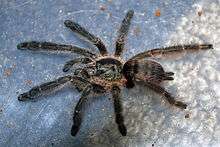Tapinauchenius
Tapinauchenius is a genus of tarantulas that was first described by Anton Ausserer in 1871.[2] The name is a combination of the Greek ταπεινός, meaning "low", and αὐχήν, meaning "neck".[3] Several species, including T. gigas, have been moved to Pseudoclamoris.[1]
| Tapinauchenius | |
|---|---|
 | |
| Tapinauchenius cupreus | |
| Scientific classification | |
| Kingdom: | Animalia |
| Phylum: | Arthropoda |
| Subphylum: | Chelicerata |
| Class: | Arachnida |
| Order: | Araneae |
| Infraorder: | Mygalomorphae |
| Family: | Theraphosidae |
| Genus: | Tapinauchenius Ausserer, 1871[1] |
| Type species | |
| T. plumipes (C. L. Koch, 1842) | |
| Species | |
|
9, see text | |
Description
They have true iridescent colors that change based on the amount of light and viewing angle. They are relatively small compared to sister genus Psalmopoeus, averaging about 4 to 4.5 inches (100 to 110 mm) long. They lack urticating hairs and are arboreal, often found in tree cavities. Many species have "dimples" on the abdomen, but this feature is not universal. Although their behavior is defensive, they lack both urticating hairs and the ability to stridulate, giving them a very mild venom. Their egg sacs can contain up to 200 spiderlings.
Pet ownership
This genus is well known by hobbyists for their incredible speed and striking coloration, but is not recommended for inexperienced owners. They are extremely skittish and defensive, and combined with their speed, handling them is not recommended. They thrive in environments that mimic the tropics, with a temperature from 70 to 80 °F (21 to 27 °C) and a relative humidity of 70% to 85%. The height of their enclosure is more important than floor space, preferring 14 inches (360 mm) of height and at least 7 to 8 inches (180 to 200 mm) of floor space. They prefer organic potting soil with the wood removed, though similar substrates can be substituted. Their diet consists of crickets, roaches, worms, or generic tarantula food, and most need a shallow dish of water or occasional misting. With proper care, these spiders can live for up to eighteen years.
Species
The genus Tapinauchenius was erected by Anton Ausserer in 1871 for the species Tapinauchenius plumipes, first described by Carl Ludwig Koch in 1842 in the genus Mygale and then moved by him to the genus Eurypelma.[1][3] As of August 2019 it contains nine species, found only in South America, on Saint Vincent and the Grenadines, and Saint Lucia:[1]
- Tapinauchenius brunneus Schmidt, 1995 – Brazil
- Tapinauchenius concolor (Caporiacco, 1947) – Guyana
- Tapinauchenius cupreus Schmidt & Bauer, 1996 – Ecuador
- Tapinauchenius latipes L. Koch, 1875 – Venezuela
- Tapinauchenius plumipes (C. L. Koch, 1842) (type) – Suriname
- Tapinauchenius polybotes Hüsser, 2018 – Lesser Antilles (St. Lucia)
- Tapinauchenius rasti Hüsser, 2018 – Lesser Antilles (St. Vincent and the Grenadines)
- Tapinauchenius sanctivincenti (Walckenaer, 1837) – St. Vincent
- Tapinauchenius violaceus (Mello-Leitão, 1930) – French Guiana, Brazil
See also
References
- "Gen. Tapinauchenius Ausserer, 1871". World Spider Catalog Version 20.0. Natural History Museum Bern. 2019. doi:10.24436/2. Retrieved 2019-09-27.
- Ausserer, A. (1871). "Beiträge zur Kenntniss der Arachniden-Familie der Territelariae Thorell (Mygalidae Autor)". Verhandlungen der Kaiserlich-Königlichen Zoologisch-Botanischen Gesellschaft in Wien. 21: 117–224.
- Ausserer, Anton (1871). Beiträge zur Kenntniss der Arachniden-Familie der Territelariae Thorell (Mygalidae Autor) (in German). Vienna: Überreuter. p. 201. Retrieved 22 February 2013.